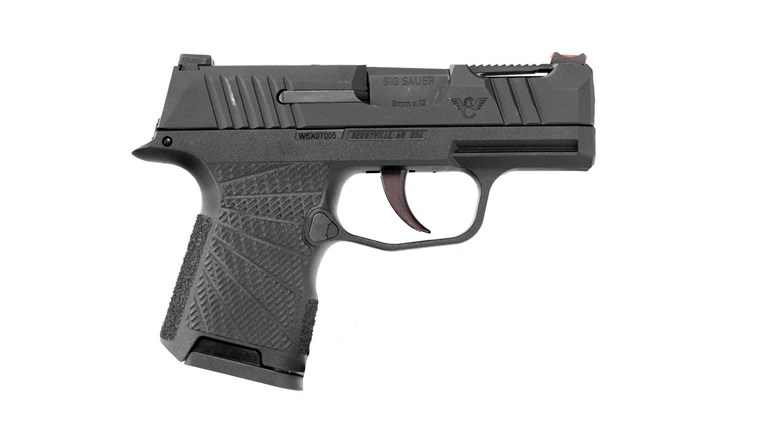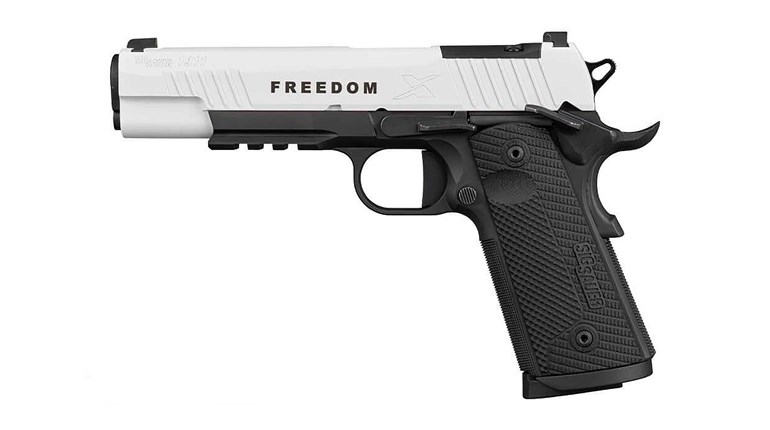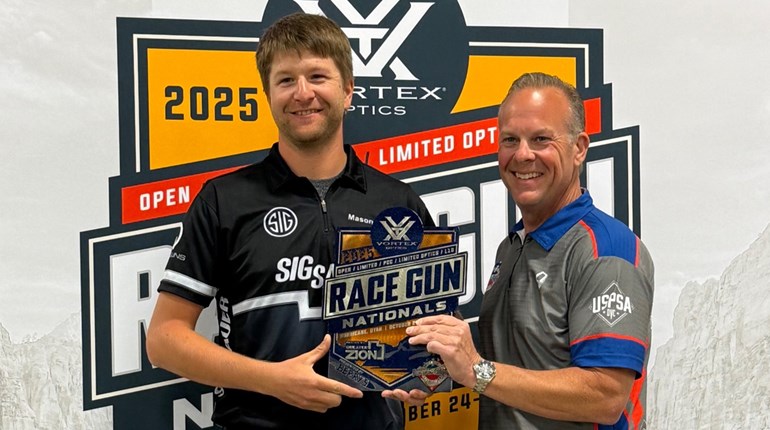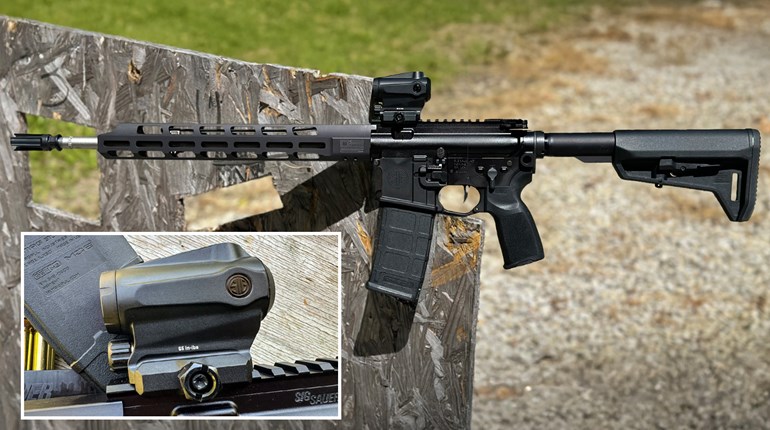
I have no doubt that when SIG Sauer released its Legion Series there were a good number of guys in the community who rolled their eyes, patted their weave and complained about how pretentious and gimmicky it was.
And they were right. The whole Illuminati, members-only vibe leaves the series wide open to that criticism, but ask me if I care? Absolutely not. If I spend $1,100 dollars on a gun, and you want to make me feel like an extra from 300, then have at it.
However, if you’re a tactical masochist, the idea of the lifestyle branding that the SIG Sauer Legion Series clearly is will nauseate you, and to that I say, “Throw up in peace.” Moving on. This Legion P229 has a sort of delayed beauty to it, in that it takes a minute to realize it—the same way I didn’t appreciate the pure beauty of Missandei from Game of Thrones until the sixth season.
My introduction to the Legion Series came in the form of a gray egg-carton-looking case adorned with a symbol that, to my eyes, looked like a paper clip gone wrong. However, the smarter parts of my brain understood it to be a sort of 21st century rendition of the Spartan lambda—at least I think. I will say, over time I’ve come to love this case and its tactical Illuminati symbol.
Opening the case revealed a modern minimalist display of tactical-ness that honestly made me proud. Immediately my eye panned over to the P229, then the two magazines, and lastly the Spartan-style silver coin that serves as a sort of benign pleasure.
This Legion P229 has a sort of delayed beauty to it, in that it takes a minute to realize it—the same way I didn’t appreciate the pure beauty of Missandei from Game of Thrones until the sixth season. The gold Legion symbol on the grips are my favorite visual attribute of the gun. It looks like it was ripped from the arms of a Spartan soldier, and it provides a nice contrast to the gray Nitron PVD finish of the slide and frame and the black checkered G-10 grips.
As good as this gun looks, the form definitely follows its function. For instance, the G-10 grips feel incredible. They’re grippy without being too harsh. The reduced beavertail is supposed to aid in concealment, which I can’t deny that it does, although I prefer the looks of the full-sized beavertail. The decocking and slide levers have a reduced profile, coupled with a rough texture to stay out of your way when you don’t need them; still, they’re right there when you need them to be.
Speaking of texture, there are patches of rough checkering cleverly placed on the gun like it’s suffering from a case of dermatitis. Along with the decocking and slide levers, there’s checkering under the trigger guard, front strap and magazine release that, like the grips, are grippy but not overly harsh.
The trigger is easily my favorite part of the gun. I remember the first time I felt an SRT trigger on a SIG: To this day I still think it’s one of the best single-action/double-action triggers on the market. As good as the SRT trigger is, this one is better. It’s not a bulls-eye trigger, it’s an epic combat trigger. This trigger is a combination of the Grayguns Inc. Intermediate Adjustable Trigger with an enhanced polished action with SRT. The double-action pull is clean—not smooth, but clean. Yes, there’s a difference. Smooth triggers have an almost squishy feel, as if you’re pulling the trigger into a vat of that stuff the dentist uses to make moldings of your teeth. Clean triggers have more of a gliding sensation, as if you were swinging on a swing. The trigger on the Legion pistol is definitely the latter. The reset is impeccable. That’s not hyperbole, folks: The reset is incredible. There is some creep after you get past the wall, but like I said, it’s an epic combat trigger. As good as the SRT trigger is, this one is better. It’s not a bulls-eye trigger, it’s an epic combat trigger.
When I first saw the SIG X-Ray high-visibility day/night sights, I thought I was going to hate them. I like my sights small and bright. Bright they were, small they were not, and I was not looking forward to using them. Then I started shooting the gun, and as I tried to shoot faster, I realized that I love these freaking sights. They’re “stare at the sun too long” bright, minus the part where you burn off your cornea. Instead of my eyes picking up the sight, it’s like the sights were visually sucking me in. I love it. The rear sights do what good friends should do when they see me talking to Rochelle Hathaway—aka tannedandtraveled on Instagram—trying to convince her that it’s only stalking if I like 10 pics in a row: fade into the background until I’m done, instead of trying to be a part of the show like other rear sights on the market, or shitty friends.
Okay, I admit that was an unnecessarily long analogy.
I press check my gun quite a bit, and I can’t tell if it’s because it actually makes sense or because it makes me feel cooler than I really am when I do it. Either way, the front cocking serrations makes this sort of tactical peacocking a lot easier. There’s an X5 undercut where the trigger guard and front strap meet that I believe will be under-appreciated by most people until they pick up a SIG that doesn’t have this feature.
If I had to describe the shooting characteristics of this gun in one word, it’d be “natural.” Seemingly all of these little and not-so-little enhancements come together and make for a very easy shooting experience. There was no learning curve with this gun. I didn’t shoot it for the first time and gawk at how awesome it was to shoot; it was more like putting on my favorite T-shirt. It just kind of became a part of me. It simply shot really, really well. The recoil was there, but I barely noticed it. I didn’t realize how little recoil it had until I shot my Glock 19 immediately afterwards. It still suffers from the notoriously low-bore access common in almost every SIG, but none of that really mattered. The gun didn’t have a tendency to flip unless I was shooting at distance and wasn’t gripping the gun very much.
Speaking of shooting at distance, I was surprised at my ability to hit a man-sized target at 186 yards several times with this gun. The sights were pretty much covering the entire target, but I still managed.
There are some people who buy a product and don’t care much for anything else that comes with it. Then there are those people who go to certain restaurants for reasons beyond, “The eggplant rollatini is to die for.” They also go for the small things, like the live music, the perfect lighting, the cozy booths and the staff that treats them like family instead of just another table. All of these small things create an experience they desire, and—here’s a little secret—a lot of these people also buy guns. Clearly these are the people SIG is going for with their Legion Series. Just spend three minutes with the gun, and it will sell itself. The gun is that good.
See, here’s the thing: Buying a Legion pistol is a trip wire of sorts for access to a host of other value-added items and features. Once you register with SIG, you receive the custom-fitted pistol case and unique challenge coin specific to your model. The case comes with a cutout for the corresponding Legion knife, from the likes of Rick Hinderer, Daniel Winkler, Quartermaster, Emerson, Strider and Kershaw. You get members-only access through the SIG store to exclusive promotions and merchandise that I will admit looks pretty nice. But I have to be honest in saying that none of these things are necessary to sell the P229 that I have. Just spend three minutes with the gun, and it will sell itself. The gun is that good.
The gun easily overshadows all of the extras that it comes with. At a projected street price of $1,100, it’s in keeping with SIG’s proud pricing structure, but I think it’s worth it—and that’s just factoring in the gun alone. When you account for all of the other extras that come with purchasing a Legion Series pistol, it’s a lot of damn icing on a cake that’s damn good to begin with.


































